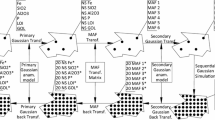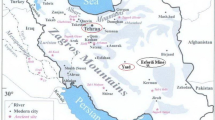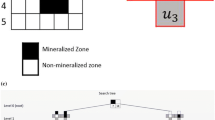Abstract
Grade estimation is very important in designing open pits. In the process of grade estimation, underestimation can result in loss of economic ore, whereas overestimation would unnecessarily increase stripping ratio. Normally, kriging method, which suffers from underestimation and/or overestimation due to smoothing effect, is used for grade estimation. To overcome drawbacks of the kriging method, more efficient techniques such as conditional simulation can be applied. In this paper, utilizing sequential Gaussian conditional simulation, grade models were constructed for Sungun copper deposit situated in the North West of Iran. According to the obtained results, it was observed that conditional simulation can effectively cope with the weakness of kriging method. Also, it was observed that as compared to the kriging method, grade distribution, resulted from the conditional simulation, is almost identical to that of the real exploration data. Accordingly, using conditional simulation, the amount of mineable ore was significantly increased, and also, average net present value as the mines’ most important economic indicator was improved by 40%.
Similar content being viewed by others
Avoid common mistakes on your manuscript.
Introduction
The ultimate pit limit, which defines the shape of a mine at the end of its life, is important for determining mine layout and net present value (NPV). Establishment of a precise grade model for deposit is one of first attempts during determination of the ultimate pit limit. The significance of the grade estimation is well acknowledged in the literature. According to Dominy et al. (2002), from 1983 to 1987, the majority of the gold mines did not reach to the predicted production goals in the preliminary years and initially estimated grades was achieved only in few mines. Studies performed by Knoll (1989) and Clow (1991) on the gold mines of Canada showed that just few number of the mine were operating according to the original mine design. A study performed by Baker and Giacomo (1998) on Australia mines indicated that out of 48 mining projects, 9 achieved 20% less and 13 realized 20% more reserves than what forecasted initially. These cases are in the agreement with results obtained from a survey conducted by the World Bank in which it is seen that most of the mining projects in Canada and USA have been faced with severe financial loss due to inaccurate ore and reserve estimation (Vallee 2000).
In the conventional grade modeling (David 1977, 1988), undesirable events such as underestimating and/or overestimating due to smoothing effect may occur, which in turn can decrease spatial variability. In this condition, application of smoothing method in the grade modeling is not recommended (Deustech and Journel 1998; Sinclair and Blackwell 2004; Webster and Oliver 2007). To overcome drawbacks of the conventional method and especially to consider uncertainty during ore grade estimation, rather newly applied methods such as conditional simulation may be very useful (Dimitrakopoulos 1990; Journel 1992; Armstrong and Dowd 1994). In the conditional simulation technique, Mont Carlo method is used to evaluate grade estimation (Snowden et al. 2002). This technique uses geostatisical parameters to construct number of grade distribution realizations with equal probablity (Deustech and Journel 1998; Chiles and Delfiner 1999). Ravenscroft (1992); Dimitrakopoulos (1998); Smith and Dimitrakopoulos (1999) used conditional simulation for entertaining grade uncertainty in to various related aspects of ore body modeling in open pit mining such as production scheduling. Kumral and Dowd (2001) used the same technique annealing method for short-term scheduling. In another investigation, Dimitrakopoulos et al. (2002) applied conditional simulation and showed that planning with a single kriged ore body model may cause remarkable deviation from the project targets. In an additional research, Dimitrakopoulos et al. (2007) proposed a new approach in which different deposit simulations (models) were compared, and the best one was selected. Moreover, Menabde et al. (2007); Ramazan and Dimitrakopoulos (2007) utilized the integrated conditional simulation and stochastic integer programming for the NPV maximization. Furthermore, Whittle and Bozorgebrahimi (2007) presented hybrids pits for incorporating conditional simulation method in to the generation of the ultimate pit. Many other studies have been given in the literature regarding application of conditional simulation (Magri et al. 2003; Leite and Dimitrakopoulos 2007; Vizi 2008; Harrison et al. 2009; Asghari et al. 2009).
In this paper, in the first step using Datamine software (Studio 3 Help 2007) geological block model was constructed for Sungun copper mine and implemented in the geostatistical analysis by conditional simulation. Thereafter, considering economic block model, the open pit parameters including average grade, minable reserve, waste tonnage, and net present value were determined using the NPV scheduler software(NPV Scheduler Help 2007) for both the methods.
Simulation background
Unlike kriging method, conditional simulation generates grade models that do not suffer from the smoothing effect and therefore can be utilized for investigating intrinsic uncertainty related to the estimated attributes such as ore grades (Dimitrakopoulos 1998). In the conditional simulation, there are various approaches to be used in the simulation process; however, sequential Gaussian simulation (SGS) is the easiest method to simulate a multivariate field. In the sequential conditional simulation, each entity is simulated sequentially based on its normal conditional cumulative distribution. In this sequential method, conditional state is generated by using the original data as well as the simulated data in the previous stages that are situated in the neighborhood locations (Webster and Oliver 2007). The fundamental steps in SGS algorithm are depicted in Fig. 1:
Fundamental steps in SGS algorithm (Webster and Oliver 2007)
Case study
Sungun copper deposit located in a mountainous region is situated 75 km northwest of Ahar, in the East Azerbaijan Province, between 46°43′E longitudes and 38°42′N latitudes with average altitude of 2,000 m above the sea level. This region is placed on progeny belt of Alps–Himalayan and has a wet climate with moderate to cold temperature. Sungun copper deposit is a porphyry-type and sulfuric minerals of copper are replaced in a semi-deep porphyry Monzonite mass. The Monzonite mass is surrounded by upper cretaceous limestones and tertiary volcanic andesite–latite.
In this paper, part of the Sungun deposit having sufficient exploration information was considered as the study area. The information includes 111 boreholes (16,014 samples) with azimuths of 0–317° and dips of 10–90°. The grade information obtained from the boreholes contains copper assays in all of the porphyry zones, i.e., leach, supergene, and hypogene. Statistical parameters of the distributions are given in Table 1.
Geostatistical analysis
To start geostatistical analysis, it is necessary to perform a preliminary statistical analysis comprising compositing, recognizing outlier data, finding out trends, and if necessary, conversion of abnormal to normal distributions (Deustech and Journel 1998). Carrying out statistical analysis, it was found that 6.25 m composite length is appropriate for the analysis. Dorfel test was performed to distinguish the outlier data, which showed no outliers in the supergene and hypogene zones, whereas in the leach zone, a threshold of 0.464 was obtained (Table 2). Also no specific trend for grade was distinguished. In the last step, normal standard distribution can be introduced.
Normally, to find out probable spatial coherence in the data, variography is fulfilled. To produce a 3D variogram, the composite length of 6.25 m was uniformly applied. Trying various lag distance, it was found that a lag of 50 m gives the best fit for spherical model applicable in porphyry zones. Observing the obtained variograms, neither regional nor geometric anisotropy was detected. Specifications of the spherical models are given in Table 3.
With the help of variography results, block ordinary kriging was performed to assign a grade to each block. For this, block dimensions of 12.5 × 25 × 25 m were chosen according to exploration information. Using a trial and error mechanism, the optimum parameters for ordinary kriging was determined (Table 4). Also, Table 5 gives parameters of estimation blocks frequency distribution. From Table 5, it is seen that as compared to the original data, standard deviation for various zones is decreased due to smoothing effect.
Conditional simulation
Sequential Gaussian conditional simulation is the most efficient method in obtaining grade distribution (Deustech and Journel 1998). To obtain a reliable result from applying this simulation technique, 50 realizations of the deposit seems to be sufficient (Dimitrakopoulos et al. 2002). It should be noted that statistical features of the conditional simulation outputs would be very similar to that of the original data. Figures 2 and 3 show close matching of the statistical parameters, variograms, and covariograms of the realizations and the original data, respectively, for the hypogene zone. Moreover, grade distribution curve obtained from kriging and conditional simulation for this zone is shown in Fig. 4. As it can also be inferred from this figure, due to smoothing effect variance of the kriging estimations, is much less than variance existed in the original data and simulated realizations. The same trend was observed in the other porphyry zones (i.e., Leach and Supergene).
Determining final pit limit using LG algorithm
To determine final pit limit, Lerches and Grossman (LG) algorithm was adopted. For this, in the first step, considering economic parameters given in Table 6 (Pars Olang Engineering Consultant 2002), economic block models were prepared incorporating grades obtained from the kriging and conditional simulation realizations. Then, using LG algorithm final pit limit for each case was identified, and accordingly, parameters including ore tonnage, waste tonnage, average grade, and static NPV, were calculated (Fig. 5). Moreover, in Table 7, details of the final pits of both the conventional kriging method and conditional simulations are presented. As it can be inferred from Table 7 and Fig. 5, the pits resulted from conditional simulation gives more ore recovery as compared to the pit obtained from kriging method. However, higher ore recovery cannot be considered as the solitary economic index for selecting the optimum pit, and final decision is made according to the achievable NPV. From NPV point of view, the pits resulted from conditional simulation provide higher NPV (123 M$) as compared to the kriging method-based pit NPV (73 M$).
Conclusion
In this paper, superiority of conditional simulation over conventional kriging method was investigated in grade estimation. Destructive smoothing effect of the kriging method is the main cause of the kriging grade estimation inaccuracy. Using sequential Gaussian conditional simulation technique, 50 realizations of the ore body were constructed, which proved high conformity of the conditional simulation grade distribution to that of the original data. Accordingly, the pit obtained from conditional simulation has more mineable ore as compared to the kriging-based pit. Also, average NPV of the conditional simulation-based pits is significantly (123 M$) higher than that of kriging method NPV (73 M$).
References
Armstrong M, Dowd PA (1994) Geostatistical simulations. Kluwer Academic Publishers, Dordtrecht
Asghari O, Soltani F, Bakhshandeh Amnieh H (2009) The comparison between sequential gaussian simulation (SGS) of Choghart ore deposit and geostatistical estimation through ordinary kriging. Aust J Basic Appl Sci 3(1):330–341
Baker CT, Giacomo SM (1998) Resource and Reserve: their uses and abuses by the equity markets. In: Ore reserve and finance: A Joint Seminar between Australasian Institute of Mining and Metallurgy and ASX, Sydney
Clow G (1991) Why gold mines fail. North Min Mag 6(2):31–34
Chiles JP, Delfiner P (1999) Geostatistics modeling spatial uncertainty. John Wiley & Sons, New York
Datamine, studio 3 Help (2007)
David M (1977) Geostatistical ore reserve estimation. Elsevier Scientific Publisher, Netherlands
David M (1988) Handbook of applied advanced geostatistical ore reserve estimation. Elsevier Scientific Publisher, Netherlands
Deustech CV, Journel AG (1998) GSLIB: geostatistical software library and user’s guide, 2nd edn. Oxford University Press, New York
Dimitrakopoulos R (1990) Conditional simulation of intrinsic random functions of order k. Math Geol 22:361–380
Dimitrakopoulos R (1998) Conditional simulation algorithms for modelling orebody uncertainty in open pitoptimisation. Int J Min Reclamat Environ 12:173–179
Dimitrakopoulos R, Farrelly V, Godoy MC (2002) Moving forward from traditional optimization: grade uncertainty and risk effects in open-pit design. Transactions of the Institutions of Mining and Metallurgy, Section A: Mining Technology 111:A82–A89
Dimitrakopoulos R, Martinez L, Ramazan S (2007) A maximum upside/minimum downside approach to the traditional optimization of open pit mine design. J Min Sci 43(1):73–82
Dominy SC, Annels AE, Noppe M (2002) Errors and uncertainty in ore reserve estimates—operator beware. Underground Operators Conference, Townsville, pp 121–126
Harrison S, Leuangthong O, Crawford B, Oshust P (2009) Uncertainty-based grade modelling of kimberlite: a case study of the Jay kimberlite pipe, EKATI Diamond Mine, Canada. Lithos 1125:73–82
Journel AG (1992) Computer imaging in the minerals industry beyond mere aesthetics. 23rd APCOM: 3–13
Knoll K (1989) And now the bad news. North Min Mag 4(6):48–52
Kumral M, Dowd PA (2001) Short-term scheduling for industrial minerals using multi-objective simulated annealing. APCOM 2001, Phoenix, Arizona
Leite A, Dimitrakopoulos R (2007) A stochastic optimization model for open pit mine planning: application and risk analysis at a copper deposit. Transactions of the Institutions of Mining and Metallurgy, Section A: Mining Technology 116:109–118
Magri EJ, Gonzalez MA, Couble A, Emery X (2003) The influence of conditional bias in optimum ultimate pit planning. APCOM 2003, South African Institute of Mining and Metallurgy pp: 429–436
Menabde M, Froyland G, Stone P, Yeates G (2007) Mining schedule optimisation for conditionally simulated orebodies. Orebody Modelling and Strategic Mine Planning, Spectrum Series 14: 379–383 (The Australasian Institute of Mining and Metallurgy: Melbourne)
NPV Scheduler Help (2007)
Pars Olang Engineering Consultant (2002) Sungun project financial and economical report
Ramazan S, Dimitrakopoulos R (2007) Stochastic optimisation of long-term production scheduling for open pit mines with a new integer programming formulation. Orebody Modelling and Strategic Mine Planning, Spectrum Series 14:359–365 (The Australasian Institute of Mining and Metallurgy: Melbourne)
Ravenscroft PJ (1992) Risk analysis for mine scheduling by conditional simulation. Transactions of the Institutions of Mining and Metallurgy, Section A: Mining Technology 101:A104–A108
Sinclair AJ, Blackwell GH (2004) Applied mineral inventory estimation. Cambridge University Press, Cambridge
Smith M, Dimitrakopoulos R (1999) The influence of deposit uncertainty on mine production scheduling. Int J Min Reclamat Environ 13:173–178
Snowden DV, Glacken I, Noppe M (2002) Dealing with demands of technical variability and uncertainty along the mine value chain. Value Tracking Symposium, Brisbane
Vallee M (2000) Mineral resource + engineering, economic and legal feasibility = ore reserve. CIM Bulletin 90:53–61
Vizi L (2008) A case study in uniform conditioning of local recoverable reserves estimation for JELŠAVA Magnesite deposit—level 220. GeoScience Engineering LIV(1):41–53
Webster R, Oliver MA (2007) Geostatistics for environmental scientists. John Wiley & Sons, New York
Whittle D, Bozorgebrahimi A (2007) Hybrid pits-linking conditional simulation and lerchs-grossmann through set theory. Orebody Modelling and Strategic Mine Planning, Spectrum Series 14:323–328 (The Australasian Institute of Mining and Metallurgy: Melbourne)
Author information
Authors and Affiliations
Corresponding author
Rights and permissions
About this article
Cite this article
Monjezi, M., Kashani, M.R. & Ataei, M. A comparative study between sequential Gaussian simulation and kriging method grade modeling in open-pit mining. Arab J Geosci 6, 123–128 (2013). https://doi.org/10.1007/s12517-011-0293-8
Received:
Accepted:
Published:
Issue Date:
DOI: https://doi.org/10.1007/s12517-011-0293-8









